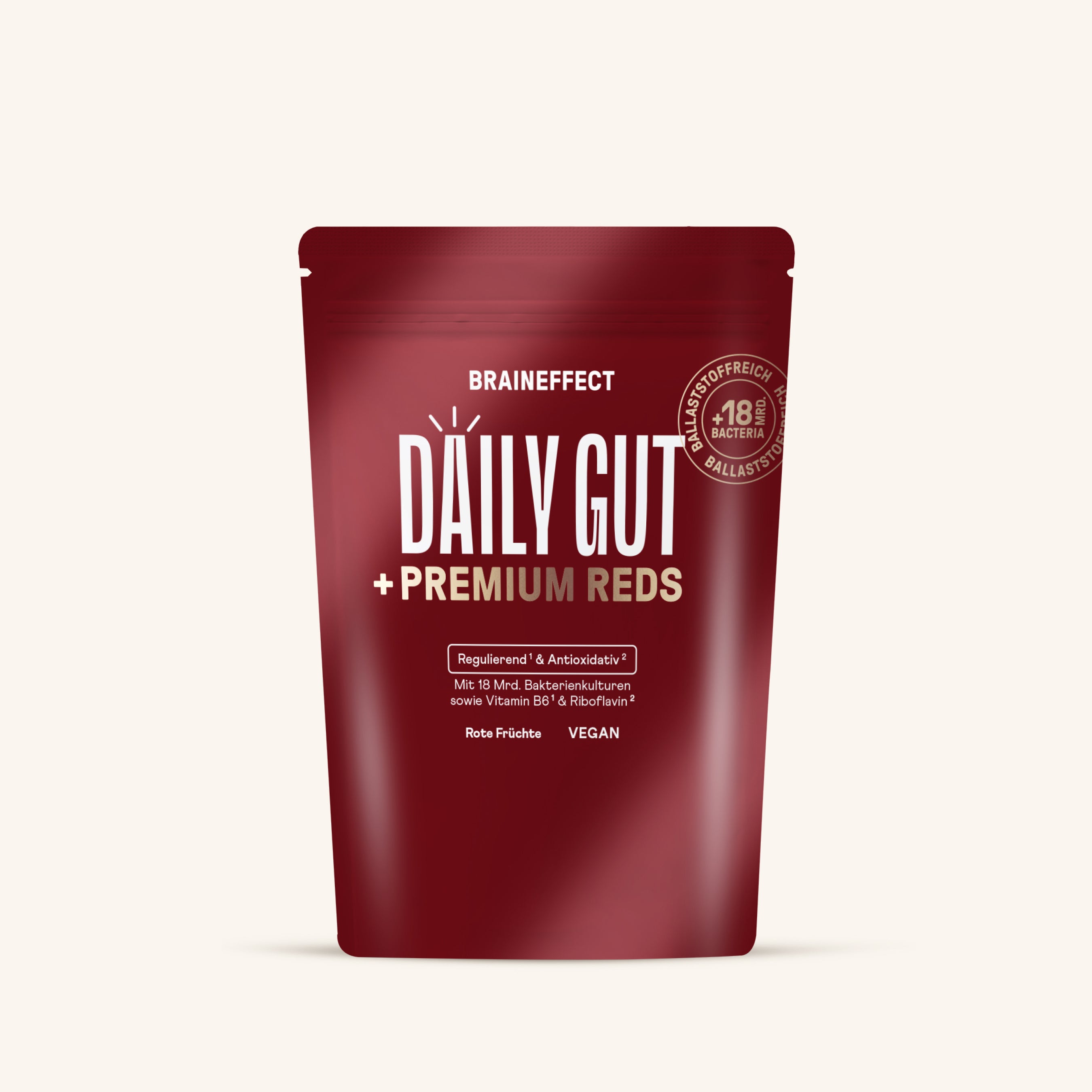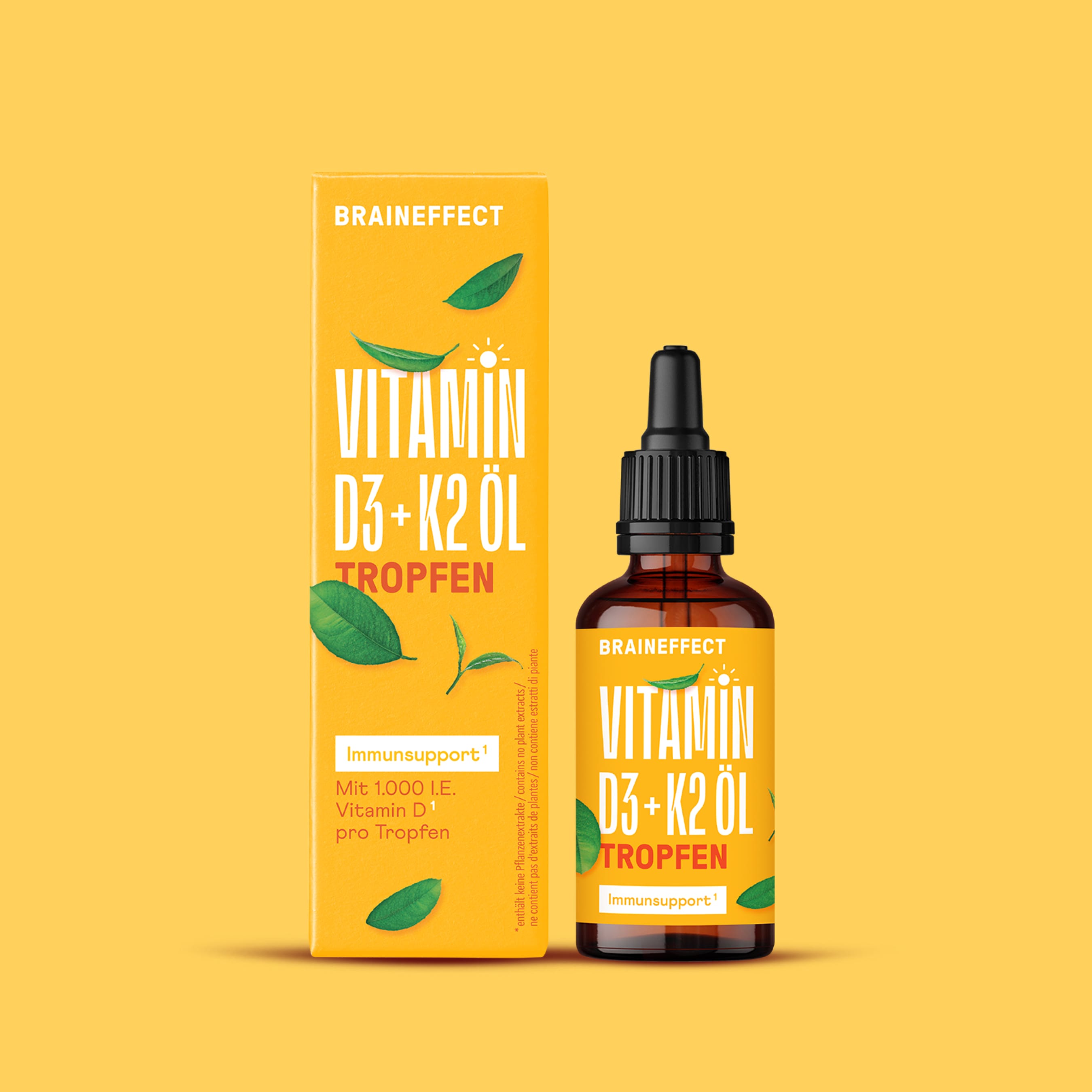Vitamin D is one of the most important vitamins. It is also called the sun vitamin, because it is not only contained in food but can also be produced by you through your skin if you are exposed to enough sunlight.
However, in winter, with a lot of stress and an unbalanced diet, a vitamin D deficiency can occur. 1] We will tell you how you can recognize a vitamin D deficiency and how you can remedy it.
Doctors and researchers agree: Vitamin D supports your immune system and is an important part of many other processes in your body.
Table of contents
- What is vitamin D?
- How does vitamin D work in your body?
- Vitamin D requirement: How much vitamin D do you need?
- Vitamin D Deficiency
- Vitamin D deficiency and its causes
- Vitamin D deficiency - the symptoms
- Vitamin D deficiency - a test brings clarity
- Remedy vitamin D deficiency
- Vitamin D in combination with vitamin K2
- Your vitamin D product
- Conclusion
- Sources
1. What is vitamin D?
There are numerous myths surrounding the so-called sun vitamin and the good tips on how to improve your vitamin D balance are countless. In addition to a diet containing vitamin D, you can also produce vitamin D yourself. All you need is UV-B radiation. This can be used to produce the body's own vitamin D3. A daily sunbath of 15-20 minutes is essential for this, whereby the face, arms, and legs should not be covered.
Especially for women who rely on day creams with sun protection factors, it is often not so easy to produce vitamin D through the skin. Because: The sun protection factor inhibits the production. If you take a short walk in the sun in the morning before applying the cream, you are not only doing something good for your well-being.
Take-Home Message #1: Vitamin D is also known as the sun vitamin because, in addition to a balanced diet, it can also be produced through the sun's UV-B radiation.
2. How does vitamin D work in your body?
But why is the vitamin so important and essential for you? To do this, you must first look at how it works. Vitamin D does not actually belong to the group of vitamins. These are substances that cannot be produced by the body itself. Vitamin D, on the other hand, is to a certain extent already contained in the body. Namely as inactive precursor 7-dehydrocholesterol.
The UV radiation activates the active substance cholecalciferol, among others. First, however, it has to undergo a conversion step and becomes the hormone "Calcitriol". Among other things, this hormone affects the supply of calcium to the body. This, in turn, affects your bones. Calcitriol also modulates the immune system.
On a mental level, sufficient supply is also important. It has an influence on the normal functioning of our hardware and thus not only ensures a "quick brain" but also normal muscle function. Vitamin D is therefore particularly important for embryos and babies.
Biochemically, it is involved in brain development. Thus pregnant women have an increased need or should take care not to suffer from any deficiency. Vitamin D has another important function in the body. It regulates the Brain messenger substance Serotonin , also called the Feel-good hormone, and thus indirectly affects your mood. If there is just too much of the vitamin in the blood, it is converted into its storage form 25(OH)Vitamin D3 and stored.
Vitamin D is essential for...
- your bones
- to support your immune system
- the cell division
- the production of serotonin
3. Vitamin D requirement: How much vitamin D do you need?
How much vitamin D is needed basically depends on each individual person. Each individual produces vitamin D at a different rate and in different amounts. For example, the body's own production is significantly slower in older people. Pregnant women also have an increased need, as the embryo also needs to be supplied with vitamin D.
Your skin color also has a significant influence on the formation of vitamin D. The lighter your skin is, the faster vitamin D can be produced. This is a particular problem for people with dark skin color who live in northern latitudes with little sunlight.
If one assumes a main type II to III (light to medium skin color), the constant minimum value is 75 nmol/l, ideally, a supply from 100 nmol/l is recommended. For comparison, 10 to 20 nmol/l vitamin D is produced in the summer midday sun and released into the blood over the next 24 hours.
As a rule of thumb for sunbathing, if the skin starts to redden, you should get out of the sun or apply sunscreen. After that, the body produces very little vitamin D. If you want to know how much vitamin D you need, you can take a blood test. You can either go to your doctor or do it from the comfort of your own home.
Take-Home Message #2: How much vitamin D each person needs is very individual and depends on various factors such as skin color, age, and weight. It is best to take a vitamin D test to check your vitamin D level.

4. Vitamin D Deficiency
A large-scale study by the Robert Koch Institute shows that about 50% of Germans are not optimally supplied with vitamin D.² The supply is very much dependent on various factors. These include the nutritional status, age, working environment (indoor/outdoor), skin tone and pigmentation, calcium intake and of course sunlight.
The latter in particular is essential for the production of vitamin D in your body, as you have already learned in the article above. Together with a generally low vitamin D intake with food, this leads to an increased risk of vitamin D deficiency.3
A vitamin D deficiency can have consequences for your health. A vitamin D deficiency ensures that certain processes concerning the immune system, muscles, and cell division can no longer run optimally. This can affect your overall performance.
5. Vitamin D deficiency and its causes
But why do so many Germans suffer from a lack of this important substance and some even in summer? A study conducted by the University of Wisconsin looked more closely at the possible causes of vitamin D deficiency in summer.4 They found that many people are in a deficit even though they actually spend a lot of time in the sun. There are several possible causes:
1. The latitude
The latitude determines how intense solar radiation is or not. Regions north of Barcelona (42nd degree of latitude) and south of Berlin (52nd degree of latitude) are sufficiently supplied with the sun during the summer months. All regions north of Berlin do not have enough sun even in summer. The majority of Germany is therefore sufficiently supplied with the sun at least in the summer months.
2. Unbalanced nutrition
Vitamin D is also contained in some foods. Above all cod liver oil, eel, herring, salmon, oysters, tuna, various types of mushrooms, avocados, eggs or cheese contain a not to be underestimated amount of vitamin D. However, if you do not take care to eat some of these foods regularly, a vitamin D deficiency can quickly develop.
3. Office work & long clothes
Whether the sun is shining in summer or not, many of them also do not have the possibility to take advantage of the sunshine hours and spend 8-10 hours a day indoors. Do you work in an office too? Then you feel like most people. Only a few people have a daily activity that takes them outdoors and into the sun.
If you sit in the office all day, it doesn't matter what time of year it is. Even if you take advantage of the last few hours of sunshine after a long day at work, it doesn't help much with a low vitamin D diet. In the evening, the sun is already lower and the UV radiation is no longer as intense. This is accompanied by another vitamin D3 killer.
People who just come out of the office rarely wear short shorts and tops. However, it is important that a large part of the skin is exposed to the sun in order to be able to produce sufficient vitamin D3. Only the face and arms are not sufficient.
So when you expose yourself to the sun for a deliberate period of time, larger areas of your skin should be free and not covered by long clothing. You should also be careful not to use any creams with UV protection before you do so, as they inhibit the formation of vitamin D.
4. Age
Another reason for the high vitamin D deficiency in Germany is surprising: the body can produce less vitamin D with increasing age. Older people are therefore potentially more at risk of having a vitamin D deficiency than others.why is this so? This correlation with age has already been shown in several studies. There are several reasons for this, which ultimately lead to a greater vitamin D deficiency than at a young age.
Older people are increasingly lacking in exercise and spend less time outdoors. They are therefore exposed to the sun much less frequently, which is, however, very essential for vitamin D production. In addition, their appetite declines with age, thus reducing the already low intake of vitamin D with food.
A third point is that the absorption of nutrients is reduced with age. Finally, the skin of older people becomes thinner and thinner, which also reduces the production of vitamin D. All this leads to a change in vitamin D metabolism and thus to a significantly increased risk of vitamin D deficiency.5
5. Skin color
How much vitamin D you need or how quickly it is produced in your skin is related to your skin color. The degree of latitude in combination with the skin color determines whether you are sufficiently supplied or not. Why? The darker the skin color, the slower vitamin D3 is synthesized by UV radiation.
Actually a meaningful function of the body, but in one case it can become a problem. People with a darker skin color who live in northern latitudes often suffer from a deficiency due to an unbalanced diet because they form vitamin D3 very slowly and there is less UV radiation.
6. Sun creams & sunblockers
Sunscreens are a sensitive topic, because on the one hand, they are extremely important, as the risk of skin cancer should not be underestimated. On the other hand: the sun protection factor contained in the creams ensures that the UV radiation contained in the sun does not reach the skin as well. This is just what is necessary for the formation of vitamin D3.
Many people no longer dare to go out into the sun without a sun protection factor, as there is a great deal of panic about the UV rays. This puts the body into a state that resembles a permanent winter. No UV rays mean no vitamin D3 formation through the skin. Nevertheless, in order not to risk long-term skin damage, you should not refrain from applying lotion. UV radiation always gets to your skin.
7. Showering after sunbathing
Especially in summer, the numerous hours of sunshine can be optimally used to do something for your vitamin D storage. Whether you go for a walk, a visit to the outdoor swimming pool or an intensive sunbath on a deckchair, you will feel the sun kissing you and then treat yourself to a relaxing shower. Sure, the sun makes you sweat and many feel the need to wash off their skin afterwards. This is a fatal mistake!
As we have already learned, vitamin D is produced in the skin. In fact, it can take up to 48 hours for all the vitamin D produced by the sun to pass from the skin to your blood. A shower directly after sunbathing will wash it all away.
A study of the University of North Texas has investigated exactly this phenomenon.6 The researchers found out that the vitamin D or the precursor vitamin D3 (cholecalciferol) is mainly formed in sebum, ie directly on the skin and not in it. The valuable substance is thus to a certain extent on your skin. This is problematic because if you grow your skin with a shower gel, it will remove the greasy parts of your skin.
So what does that mean for you? In order to retain valuable vitamin D, it is best not to shower for 4-6 hours after sunbathing. This can sometimes be problematic or even impossible. Therefore, you should at least try not to use the shower gel or not to apply it to large areas of skin.
Take-Home Message #3: As you have now learned, the sun, along with a balanced diet, is essential for the production of vitamin D in your body. Your health is important, so you should pay attention to your vitamin D level! How can you ensure it? Get out into the fresh air and the sun with you! But: Of course, you shouldn't overdo it. Because as is the case with many things, too much of a good thing is not always optimal.

6. Vitamin D deficiency - the symptoms
There are a few signs you can look out for to determine a vitamin D deficiency. But the stupid thing is that the signs of a low vitamin D deficiency are very unspecific and may have other causes.
According to studies, the following factors can be the first signs of a Vit-D deficiency:
- low well-being
- Winter blues
- weakened immune system
- you can no longer call up your normal performance during training
7. Vitamin D deficiency - a test brings clarity
In order to be sure whether a vitamin D deficiency is present, it is not sufficient to pay attention to the signs described. Only a blood test can provide certainty as to whether you have a vitamin D deficiency or not. A vitamin D test can be carried out by your family doctor, but in the meantime, there are also self-tests, which can be done at home.
In this procedure, a few drops of blood are extracted from a finger with the aid of a lancet and sent to a specialist laboratory on test strips. This laboratory then checks how much 25-OH-Vitamin-D (Calcidiol) is present in our blood - this is the form of Vitamin D as it appears in our blood. The results can then be easily viewed online.
Take-Home Message #4: There are symptoms that indicate a vitamin D deficiency, but only a blood test can give absolute certainty. This can be done either by a self-test or by the family doctor.
8. Remedy vitamin D deficiency
The blood test showed you have a vitamin D deficiency? Then you should now start firstly to compensate for the deficiency and secondly to maintain your vitamin D level. A natural supply of vitamin D is, of course, a good option, but it has now become clear that this is not always possible or easy.
Changing the diet can be a challenge. There are some foods that contain high levels of vitamin D, such as eel or animal liver. If you do not want to eat eel and liver every week, here is a suggestion for you: You can buy vitamin D supplements such as BRAINEFFECT VITAMIN D3 + OIL , which contains the important vitamin in the right dosage.
The German medical journal recommends a dosage of 1,000 IU of vitamin D per day, which corresponds to one drop of BRAINEFFECT Vitamin D3+OIL corresponds. This increases the concentration in the blood by approx. 25 nmol/l daily. The DGE currently recommends a dosage of 800 IU per day for adults. The amount varies in other countries where higher doses are actually recommended.
Here, the individual dose can best be determined with a blood test, thus optimizing the vitamin D content in the body. Accordingly, higher doses than the 800 IU recommended by the DGE should definitely be discussed with the physician after the blood test.7
In other countries, the use of preparations is already much more advanced. There, vitamin D is increasingly being added to foods such as milk, dairy products, and muesli. This can be a good option. Another option would be to make greater use of foods that contain natural vitamin D.
Furthermore, light therapies can be used to remedy vitamin D deficiency. These include daylight lamps that imitate sunlight or visiting a solarium. You can find out more about this in our light hacks.
Take-Home Message #5: A high-fat diet can help you absorb vitamin D through food. A short, unprotected sunbath is also helpful. If you cannot cope with this, supplements can help you reach normal vitamin D levels.
9. Vitamin D in combination with vitamin K2
To do something good for your bones, you can take vitamin D in combination with vitamin K2. In this case, vitamin K2 is a so-called cofactor that influences bone metabolism. Vitamin K2 ensures that calcium present in the body can be utilized. This is why high-quality vitamin D products always contain vitamin D3 and K2.
10. Your vitamin D product
Your body is a large, complex organism and needs many nutrients, such as vitamin D, to function optimally. You have learned how essential sunbathing is for its production and how some factors can, unfortunately, hinder it somewhat.
However, if you want to support your body and ensure that it is supplied with sufficient vitamin D throughout the year, you can go to BRAINEFFECT VITAMIN D3+OIL to fall back on. Since the ratio of vitamin D3 and vitamin K2 is very important for your bones, our formula also contains vitamin K2. So you can always supply your body with sufficient vitamin D, even in the cold winter months!
11. Conclusion
Vitamin D can only be produced by your body under sufficient sunlight or with the help of vitamin D rich foods. A vitamin D deficiency can lead to various symptoms and should be avoided if possible. Especially for people who work a lot in the office and older people who spend little time outside, supplementing with vitamin D is recommended. Vitamin D is best absorbed by your body in combination with vitamin K2.
12. Sources
[1] https://www.uni-hohenheim.de/uploads/media/Digitale_Pressemappe.pdf
[2] https://www.rki.de/SharedDocs/FAQ/Vitamin_D/Vitamin_D_FAQ-Liste.html
[3] https://www.ncbi.nlm.nih.gov/pmc/articles/PMC3408996C3408996
[4] https://www.ncbi.nlm.nih.gov/pubmed/17426097
[5] https://www.ncbi.nlm.nih.gov/pmc/articles/PMC3501367
[6] https://digital.library.unt.edu/ark:/67531/metadc5077/m1/304/
[7] https://www.dge.de/wissenschaft/referenzwerte/vitamin-d/
{{widget type="egproducts/list_featured" template="elegento/products/listslider.phtml"}}
















